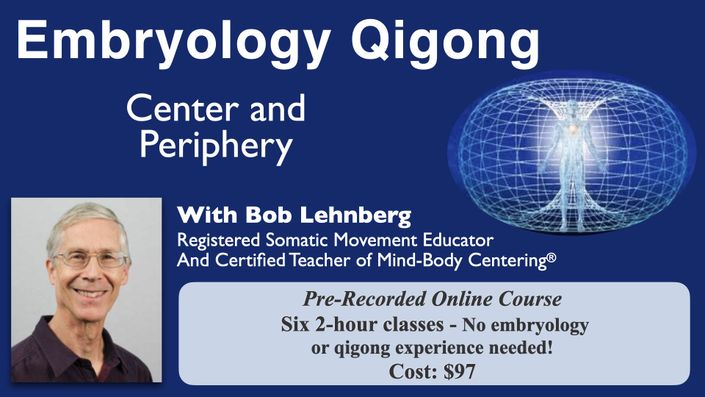
Qigong of Embryology: Center and Periphery
Live Qigong Classes with Bob Lehnberg
In this third series of Qigong and Embryology, we begin with an overview of material leading up to this point. Participants need not have done any previous classes to benefit from this series. Embryology is holographic in nature and we each enter from where we are. All are welcome to participate.
Course Description:
Our nervous system begins embryologically with a central neural tube that then connects to the most peripheral parts of our body. Sensory and motor neurons provide the communication pathways between our central nervous system and our periphery. On the other hand, our circulatory system begins with the formation of vessels and blood cells peripherally, even outside of our immediate embryonic selves. They then coalesce and develop toward our nascent heart, the center of our circulatory system. When we consider the heart, we also consider the thoracic diaphragm as their development is closely related. Our muscular system begins centrally and extends peripherally as the limbs form and grow. There is no separation of axial and appendicular musculature; it is one organ integrated through the fascial system.
In a simple view, our nervous system is quick and relays information through electrical impulses. Being more electrical, directed, and quick, it is essentially yang in nature. The circulatory system transports nutrients, wastes and chemicals to allow respiration and health in all the cells of the body. The blood and circulatory system, being more chemically weighted, omnipresent, and pervasive, is essentially yin in nature. Our muscular system provides the guidance and vitality for expressing our innermost intentions, through our trunk and limbs. Each of these qualities influences our intentions, our relationships, and qigong practice.
Class 1: Development of the Lateral Plate Mesoderm, Visceral and Somatic Layers
After a review of development up to this point, we will identify the origin and overall progression of the visceral and somatic layers of the lateral plate meso-tissue. This middle tissue creates two layers. The visceral layer lines our digestive tube, body cavity and forms the mesentery. The somatic layer develops into the structure and connective tissue of our limbs. Both layers derive from one source providing continuity of visceral and somatic functions in practice.
Class 2: Limb Development
Arms and legs appear as buds on the sides of the embryo. Mesenchyme forms the internal structure of cartilage and other connective tissue. Joints arise from cavitation of the mesenchyme and create cartilage segments. These segments serve as templates to ossify and form bones. Hand and foot “paddles” form and guide limb growth in length in a distal to proximal direction. Otherwise, joints form in a proximal to distal sequence. Eventually individual digits result from select cell growth and cell death. Distinguishing proximal and distal movement refines our practice and movement of qi.
Class 3: Limb Rotation
Rotation of our limbs results in their functionality. Our hands reach and touch while our feet stand and walk. Of course, we not that limited. Rotation of the limbs occurs in the formative connective tissue and can be seen in spirals in the bones. When we embody bone and connective tissue rotation, our joints can be at ease and not have to compensate for rotational forces. Our relationship with qi reminds us of our natural internal rotation.
Class 4: Innervation by Neural Crest Cells; Autonomic Ganglia and Somatic Nerves
Neural crest cells are so unique and multipotent that they may be considered a 4th germ layer. Among other things, they are the source for the autonomic nervous system and the sensory nerves for the muscles. Motor nerves arise from the neural tube. Between sensory input and motor output lies integration. Sensory and motor awareness and the ability to pause provides us opportunity to change our patterns. Discerning our autonomic and somatic nervous systems can lead to greater sensitivity, subtlety, and deeper intention.
Class 5: Blood Vessel Formation
Blood islands, small vessels, and early red blood cells first form in mesoderm outside of the embryo itself. Rhythmic movement and flow begin in these peripheral vessels even before we have a heart. The periphery supports the center, where all the formative forces coalesce to manifest the heart. The center and periphery support each other in a unified whole.
Class 6: Heart and Diaphragm Formation
The heart begins as a tube above the forming brain. The heart tube folds, rotates, and descends into the chest cavity where it completes development. The fully formed heart coheres the blood it receives and sends it out for another circuit. It is an organizing force for the hands and provides a center to our horizontal axis. The central tissue of the diaphragm descends along with the heart to help define the thoracic cavity. Practicing and being with a restful heart centered in the thoracic cavity engenders a serene and courageous presence.
Your Instructor

In 1990, Bob Lehnberg received his certification as Practitioner of Body-Mind Centering® (BMCsm) and in 2002 Teacher of Body-Mind Centering. Since then Bob has received teacher certifications for BMC Yoga, Integral Yoga and Supreme Science of Qigong. He has been teaching in schools of massage therapy and programs of somatic training since 1990 and has had the good fortune to teach BMC and somatic practices throughout the US and internationally in Europe, Canada, China, and Taiwan.
Bob is a co-founder of Kinesthetic Learning Center in Durham, NC and has been on faculty teaching and coordinating the BMC Somatic Movement Educator (SME) and Practitioner certification programs since 2007. He is coordinator of SME courses for Esprit en Mouvement in Montreal, Canada and is Co-director of the SME program in Taitung, Taiwan.
Course Curriculum
-
StartSession One: Development of the Lateral Plate Mesoderm, Visceral and Somatic Layers (123:28)
-
StartSession Two: Limb Development (120:53)
-
StartSession Three: Limb Rotation (121:01)
-
StartSession Four: Innervation by Neural Crest Cells; Autonomic Ganglia and Somatic Nerves (120:42)
-
StartSession Five: Blood Vessel Formation (123:39)
-
StartSession Six: Heart and Diaphragm Formation (124:37)
